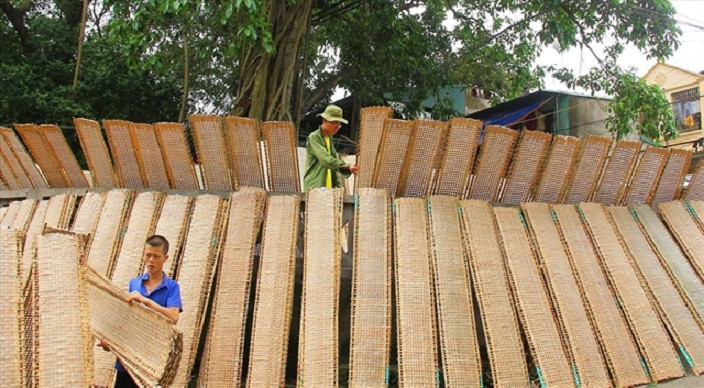
When arriving at the gate of the village in Việt Yên District recently, we saw local workers busy bringing out bamboo racks with wet rice paper hanging on to dry. They placed them everywhere along the roads to the communal house, even on house roofs and trees.
Artisan Trịnh Đắc Hạ, 70, told us that rice paper makers dry their products in the morning dew to help give them a special fragrance.
“We are busy all year round with work, and our products are available everywhere from the north to the central region and the south.
“Workers have to stay up all night to make rice paper, so as to dry it under morning dew and sunlight to get the aromatic flavour from the nature,” said Hạ, adding that the rice paper is an important 'shirt' to wrap up minced pork and other ingredients to make spring rolls, a national dish that is indispensable at important parties, particularly at Tết (Lunar New Year) holidays.
Hạ sai Thổ Hà villagers had limited land to grow paddy or potato, so they tried their best to do traditional occupations such as making peanut sweet, wine or ceramics.
The craft of making rice paper (very thin rice crepes) has long been practised here and developed prosperously, he said. At first, they sold the rice paper in the neighbourhoods of the village, but their goods’ fame spread throughout the province to other localities nationwide, and now they have been exported abroad.
Asked about the technique to make the rice paper, Hạ said it is made of quality rice which is soaked, ground, mixed with water to make thin batter, steamed, and dried.
“The process of drying determines the paper’s quality, if it rains the paper will easily be mouldy or if it is dried under strong sunlight or dry air, the paper will easily be cracked or broken," Hạ said.
He invited us to visit his household workshop and presented us several 'sheets of rice paper'. They are not too thick or too thin. They are soft and pliable so it’s easy to wrap. They do not break easily when soaked in water, being stronger than rice papers from other places.
"We don’t use food additive so our products are of good food hygiene and safety," Hạ said.
The chief of Thổ Hà Village, Cáp Trọng Việt, said the village has more than 600 households doing this work. Their living standards have been significantly improving, averagely earning VNĐ7 - 10 million per person per month.
Thổ Hà rice paper has been exported to South Korea, Japan and some European countries.
Lunar New Year festival is approaching so villagers have to work very hard to meet the increasing demand.
“We are very proud that our rice paper is indispensable ingredients for eatery chef and housewives to make fried spring rolls, a national specialty, or shrimp and pork roll salad to welcome Tết,” Việt said, adding that visitors and travellers to the village always choose this rice paper as gifts for their relatives and friends.
Ancient Thổ Hà Village, about 45km north of Hà Nội, invites guests to experience rice paper making and discover the surrounding natural beauty. VNS